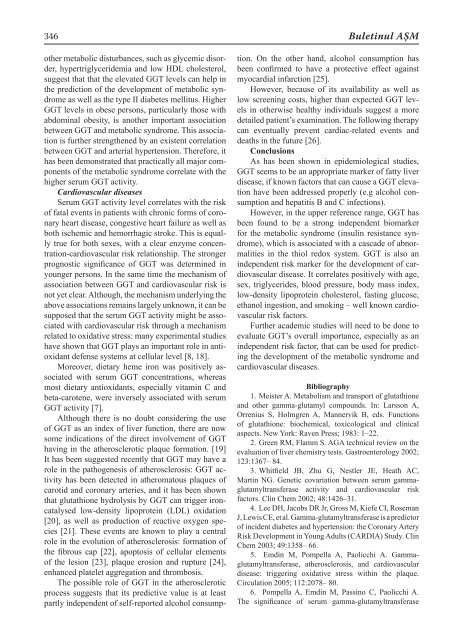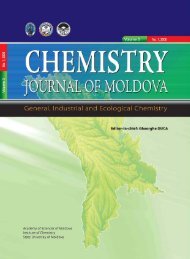stiinte med 3 2011.indd - Academia de ÅtiinÅ£e a Moldovei
stiinte med 3 2011.indd - Academia de ÅtiinÅ£e a Moldovei
stiinte med 3 2011.indd - Academia de ÅtiinÅ£e a Moldovei
You also want an ePaper? Increase the reach of your titles
YUMPU automatically turns print PDFs into web optimized ePapers that Google loves.
346<br />
Buletinul AŞM<br />
other metabolic disturbances, such as glycemic disor<strong>de</strong>r,<br />
hypertriglyceri<strong>de</strong>mia and low HDL cholesterol,<br />
suggest that that the elevated GGT levels can help in<br />
the prediction of the <strong>de</strong>velopment of metabolic syndrome<br />
as well as the type II diabetes mellitus. Higher<br />
GGT levels in obese persons, particularly those with<br />
abdominal obesity, is another important association<br />
between GGT and metabolic syndrome. This association<br />
is further strengthened by an existent correlation<br />
between GGT and arterial hypertension. Therefore, it<br />
has been <strong>de</strong>monstrated that practically all major components<br />
of the metabolic syndrome correlate with the<br />
higher serum GGT activity.<br />
Cardiovascular diseases<br />
Serum GGT activity level correlates with the risk<br />
of fatal events in patients with chronic forms of coronary<br />
heart disease, congestive heart failure as well as<br />
both ischemic and hemorrhagic stroke. This is equally<br />
true for both sexes, with a clear enzyme concentration-cardiovascular<br />
risk relationship. The stronger<br />
prognostic significance of GGT was <strong>de</strong>termined in<br />
younger persons. In the same time the mechanism of<br />
association between GGT and cardiovascular risk is<br />
not yet clear. Although, the mechanism un<strong>de</strong>rlying the<br />
above associations remains largely unknown, it can be<br />
supposed that the serum GGT activity might be associated<br />
with cardiovascular risk through a mechanism<br />
related to oxidative stress: many experimental studies<br />
have shown that GGT plays an important role in antioxidant<br />
<strong>de</strong>fense systems at cellular level [8, 18].<br />
Moreover, dietary heme iron was positively associated<br />
with serum GGT concentrations, whereas<br />
most dietary antioxidants, especially vitamin C and<br />
beta-carotene, were inversely associated with serum<br />
GGT activity [7].<br />
Although there is no doubt consi<strong>de</strong>ring the use<br />
of GGT as an in<strong>de</strong>x of liver function, there are now<br />
some indications of the direct involvement of GGT<br />
having in the atherosclerotic plaque formation. [19]<br />
It has been suggested recently that GGT may have a<br />
role in the pathogenesis of atherosclerosis: GGT activity<br />
has been <strong>de</strong>tected in atheromatous plaques of<br />
carotid and coronary arteries, and it has been shown<br />
that glutathione hydrolysis by GGT can trigger ironcatalysed<br />
low-<strong>de</strong>nsity lipoprotein (LDL) oxidation<br />
[20], as well as production of reactive oxygen species<br />
[21]. These events are known to play a central<br />
role in the evolution of atherosclerosis: formation of<br />
the fibrous cap [22], apoptosis of cellular elements<br />
of the lesion [23], plaque erosion and rupture [24],<br />
enhanced platelet aggregation and thrombosis.<br />
The possible role of GGT in the atherosclerotic<br />
process suggests that its predictive value is at least<br />
partly in<strong>de</strong>pen<strong>de</strong>nt of self-reported alcohol consumption.<br />
On the other hand, alcohol consumption has<br />
been confir<strong>med</strong> to have a protective effect against<br />
myocardial infarction [25].<br />
However, because of its availability as well as<br />
low screening costs, higher than expected GGT levels<br />
in otherwise healthy individuals suggest a more<br />
<strong>de</strong>tailed patient’s examination. The following therapy<br />
can eventually prevent cardiac-related events and<br />
<strong>de</strong>aths in the future [26].<br />
Conclusions<br />
As has been shown in epi<strong>de</strong>miological studies,<br />
GGT seems to be an appropriate marker of fatty liver<br />
disease, if known factors that can cause a GGT elevation<br />
have been addressed properly (e.g alcohol consumption<br />
and hepatitis B and C infections).<br />
However, in the upper reference range, GGT has<br />
been found to be a strong in<strong>de</strong>pen<strong>de</strong>nt biomarker<br />
for the metabolic syndrome (insulin resistance syndrome),<br />
which is associated with a casca<strong>de</strong> of abnormalities<br />
in the thiol redox system. GGT is also an<br />
in<strong>de</strong>pen<strong>de</strong>nt risk marker for the <strong>de</strong>velopment of cardiovascular<br />
disease. It correlates positively with age,<br />
sex, triglyceri<strong>de</strong>s, blood pressure, body mass in<strong>de</strong>x,<br />
low-<strong>de</strong>nsity lipoprotein cholesterol, fasting glucose,<br />
ethanol ingestion, and smoking – well known cardiovascular<br />
risk factors.<br />
Further aca<strong>de</strong>mic studies will need to be done to<br />
evaluate GGT’s overall importance, especially as an<br />
in<strong>de</strong>pen<strong>de</strong>nt risk factor, that can be used for predicting<br />
the <strong>de</strong>velopment of the metabolic syndrome and<br />
cardiovascular diseases.<br />
Bibliography<br />
1. Meister A. Metabolism and transport of glutathione<br />
and other gamma-glutamyl compounds. In: Larsson A,<br />
Orrenius S, Holmgren A, Mannervik B, eds. Functions<br />
of glutathione: biochemical, toxicological and clinical<br />
aspects. New York: Raven Press; 1983: 1–22.<br />
2. Green RM, Flamm S. AGA technical review on the<br />
evaluation of liver chemistry tests. Gastroenterology 2002;<br />
123:1367– 84.<br />
3. Whitfield JB, Zhu G, Nestler JE, Heath AC,<br />
Martin NG. Genetic covariation between serum gammaglutamyltransferase<br />
activity and cardiovascular risk<br />
factors. Clin Chem 2002; 48:1426–31.<br />
4. Lee DH, Jacobs DR Jr, Gross M, Kiefe CI, Roseman<br />
J, Lewis CE, et al. Gamma-glutamyltransferase is a predictor<br />
of inci<strong>de</strong>nt diabetes and hypertension: the Coronary Artery<br />
Risk Development in Young Adults (CARDIA) Study. Clin<br />
Chem 2003; 49:1358– 66.<br />
5. Emdin M, Pompella A, Paolicchi A. Gammaglutamyltransferase,<br />
atherosclerosis, and cardiovascular<br />
disease: triggering oxidative stress within the plaque.<br />
Circulation 2005; 112:2078– 80.<br />
6. Pompella A, Emdin M, Passino C, Paolicchi A.<br />
The significance of serum gamma-glutamyltransferase

















